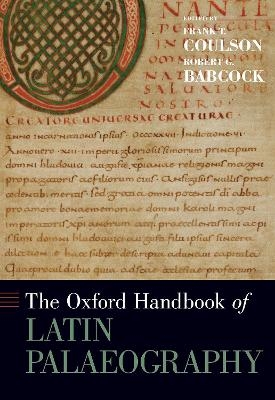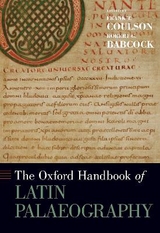The Oxford Handbook of Latin Palaeography
Oxford University Press Inc (Verlag)
978-0-19-533694-8 (ISBN)
Latin books are among the most numerous surviving artifacts of the Late Antique, Mediaeval, and Renaissance periods in European history; written in a variety of formats and scripts, they preserve the literary, philosophical, scientific, and religious heritage of the West. The Oxford Handbook of Latin Palaeography surveys these books, with special emphasis on the variety of scripts in which they were written. Palaeography, in the strictest sense, examines how the changing styles of script and the fluctuating shapes of individual letters allow the date and the place of production of books to be determined. More broadly conceived, palaeography examines the totality of early book production, ownership, dissemination, and use. The Oxford Handbook of Latin Palaeography includes essays on major types of script (Uncial, Insular, Beneventan, Visigothic, Gothic, etc.), describing what defines these distinct script types, and outlining when and where they were used. It expands on previous handbooks of the subject by incorporating select essays on less well-studied periods and regions, in particular late mediaeval Eastern Europe. The Oxford Handbook of Latin Palaeography is also distinguished from prior handbooks by its extensive focus on codicology and on the cultural settings and contexts of mediaeval books. Essays treat of various important features, formats, styles, and genres of mediaeval books, and of representative mediaeval libraries as intellectual centers. Additional studies explore questions of orality and the written word, the book trade, glossing and glossaries, and manuscript cataloguing. The extensive plates and figures in the volume will provide readers wtih clear illustrations of the major points, and the succinct bibliographies in each essay will direct them to more detailed works in the field.
Robert G. Babcock teaches Classics at the University of North Carolina at Chapel Hill. He is a Fellow of the Flemish Royal Academy of Belgium, Korrespondierendes Mitglied der Zentraldirektion of Monumenta Germaniae Historica, and has held fellowships from the Alexander von Humboldt-Stiftung and the Belgian Institute for Advanced Studies. His publications focus on Latin manuscripts, Medieval Latin, and the transmission of Classical, Patristic, and Medieval Latin literature. Frank T. Coulson is Distinguished Professor of Classics in the Department of Classics at the Ohio State University. He has published widely on the reception of Ovid in the Medieval Ages and is currently finishing a volume for the Catalogus translationum et commentariorum on Ovid's Metamorphoses. He also serves as the Director of Palaeography for the Center for Epigraphical and Palaeographical Studies.
Forward and Acknowledgements
Introduction: Frank T. Coulson, Department of Classics, The Ohio State University
A. SCRIPT
A.1 Organizing Script
1. Punctuation: Frank T. Coulson, Department of Classics, The Ohio State University
2. Abbreviations: Olaf Pluta, Institut für Philosophie, Ruhr-Universität Bochum
3. Numerals: Charles Burnett, Professor of the History of Islamic Influences on Europe, Warburg Institute
A.2 Greco-Roman Heritage
4. Old Roman Cursive: Teresa De Robertis, Dipartimento di Storia,
Archeologia, Geografia, Arte, Spettacolo - Università di Firenze (Translated from the Italian by Consuelo Dutschke)
5. New Roman Cursive: Teresa De Robertis, Dipartimento di Storia,
Archeologia, Geografia, Arte, Spettacolo - Università di Firenze (Translated from the Italian by Consuelo Dutschke)
6. Square and Rustic Capital: David Wright, The University of California, Berkeley
7. Uncial: Robert G. Babcock, University of North Carolina at Chapel Hill
8. Semi-Uncial: Robert G. Babcock, University of North Carolina at Chapel Hill
9. Greek Scripts in Latin Manuscripts: Walter Berschin, Universität Heidelberg
A.3 Early Medieval Hands
10. Beneventan: Francis Newton, Professor of Latin Emeritus, Duke University
11. Visigothic: Jesus Alturo i Perucho, Universitat Autonoma di Barcelona
12. Luxeuil: Paolo Cherubini, Professore ordinario, Università degli Studi di Milano - Bicocca
13. Merovingian Gaul: David Ganz, Visiting Professor of Palaeography, The Medieval Institute, The University of Notre Dame
14. St. Gall and Alemannic: Anna A. Grotans, Department of Germanic Languages and Literatures, The Ohio State University
15. Insular Script: Peter Stokes, King's College, University of London
A.4 Carolingian Minuscule
16. Carolingian Minuscule in France and Germany: David Ganz, Visiting Professor of Palaeography, The Medieval Institute, The University of Notre Dame
17. Early Carolingian Minuscule in Italy: Simona Gavinelli, Università Cattolica del S. Cuore, Milano
18. Late Carolingian Minuscule in Italy: Mirella Ferrari, Università Cattolica del S. Cuore, Milano
19. Tironian Notes: David Ganz, Visiting Professor of Palaeography, The Medieval Institute, The University of Notre Dame
A.5 Gothic
20. Nomenclature of Gothic Scripts: Albert Derolez Emeritus Professor at the Free Universities of Brussels
21. French Gothic: Marie-Hélène Tesnière, Conservateur général au département des Manuscrits de La Bibliothèque nationale de France (Translated from the French by Frank T. Coulson)
22. Early English Gothic: Richard Gameson, Durham University
23. Later English Gothic: Pamela Robinson, University of London
24. German Gothic: Karl-Georg Pfaendtner, Bayerische Staatsbibliothek, München
25. Early Italian Gothic: Stefano Zamponi, Università di Firenze (Translated from the Italian by Consuelo Dutschke)
26. Late Italian Gothic: Stefano Zamponi, Università di Firenze (Translated from the Italian by Consuelo Dutschke)
27. Late Dutch Gothic: J.P. Gumbert, Professor Emeritus, Leiden University
28. Czech Republic: Hana Patkova, Charles University, Prague
29. Hungary and Slovakia: Juraj Sedivý, Comenius-University in Bratislava / Faculty of Arts (Translated from the German by Anna A. Grotans and Robert G. Babcock)
30. Interaction of Script and Print: Paul Needham, Scheide Librarian, Princeton University
A.6 Humanist
31. Origins of Humanist Script: Teresa De Robertis, Dipartimento di Storia,
Archeologia, Geografia, Arte, Spettacolo - Università di Firenze (Translated from the Italian by Consuelo Dutschke)
32. Italian Humanist: Teresa De Robertis, Dipartimento di Storia, Archeologia,
Geografia, Arte, Spettacolo - Università di Firenze (Translated from the Italian by Consuelo Dutschke)
33. Byzantium and the West: Marianne Pade, Director, Danish Academy in Rome
A.7
34. The Waning of Manuscript Production: B. Gregory Hays, Department of Classics, University of Virginia
B. MATERIAL EMBODIMENT AND TECHNIQUES
35. Stages of Manuscript Production: Lucien Reynhout, Curator at the Department of Manuscripts Royal Library of Belgium, Brussels, Belgium
36. Stages in Diplomatic Production: Olivier Guyotjeannin, Directeur d'études à l'École nationale des chartes, Paris (Translated from the French by Robert G. Babcock and Frank T. Coulson)
37. Mise-en-page: Marie Hélène Tesnière, Conservateur général au département des Manuscrits de La Bibliothèque nationale de France (Translated from the French by Frank T. Coulson)
38. Format of Books: J.P. Gumbert, Professor Emeritus, Leiden University
39. Format of Documents: Olivier Guyotjeannin, Directeur d'études à l'École nationale des chartes (Paris) (Translated from the French by Robert G. Babcock and Frank T. Coulson)
40. Quantitative Codicology: Ezio Ornato, CNRS, Paris (Translated from the French by Robert G. Babcock and Frank T. Coulson)
41. Comparative Codicology: Malachi Beit-Arié, Professor Emeritus of Codicology and Palaeography, The Hebrew University of Jerusalem
42. Pen Flourishing: Alison Stones, Professor Emeritus, University of Pittsburgh
C. CULTURAL SETTING
43. Orality and Visible Culture: Paul Saenger, Newberry Library, Chicago
44. Who Were the Scribes: Alison Beach, Department of History, The Ohio State University
45. Book Trade: Antiquity and the Early Middle Ages: Guglielmo Cavallo, Accademia Nazionale dei Lincei, Roma
46. Book Trade: Central, High and Late Middle Ages: Kouky Fianu, Université d'Ottawa/University of Ottawa
D. SELECTED SCRIPTORIA AND LIBRARIES
47. An Overview: Donatella Nebbiai, Institut de recherche et d'histoire des textes, Paris (Translated from the French by Frank T. Coulson)
48. Lindisfarne: Michelle P. Brown FSA, Professor Emerita, SAS, University of London
49. Northern Italy in the 7th and 8th Centuries: Paolo Cherubini, Professore ordinario, Università degli Studi di Milano - Bicocca
50. Insular Script in its Cultural Context: Michelle P. Brown, FSA, Professor Emerita, SAS, University of London
51. Montecassino: Francis Newton, Professor of Latin Emeritus, Duke University
52. St. Gall: Anna A. Grotans, Department of Germanic Languages and Literatures, The Ohio State University
53. University of Paris: Richard and Mary Rouse, University of California, Los Angeles
54. Salisbury Cathedral Library: Teresa Webber, Trinity College, Cambridge
55. Florence: Xavier van Binnebeke, Bodleian Library, Oxford
E. VARIETIES OF BOOK USAGE
56. Books of Hours: Rowan Watson. Senior Curator, National Art Library, Word & Image Department, Victoria and Albert Museum
57. Law: Susan L'Engle, Center for Medieval and Renaissance Studies, St. Louis University
58. The Manuscript Miscellany: George Rigg, Professor Emeritus, University of Toronto
59. Florilegia: Jacqueline Hamesse, Professor Emerita, L'Université catholique de Louvain
60. Theological Texts: Lesley Smith, Professor of Medieval Intellectual History, University of Oxford, Fellow in Politics and Senior Tutor, Harris Manchester College
61. Gloss and Text: Greti Dinkova-Bruun, Pontifical Institute of Mediaeval Studies, Toronto
62. Glossaries and Grammars: Patrizia Lendinara, Dipartimento Culture e Società, Università di Palermo
63. The History of Manuscripts since 1500: B. Gregory Hays, Department of Classics, University of Virginia
64. Manuscript Cataloguing: Consuelo Dutschke, Columbia University
| Erscheinungsdatum | 06.11.2020 |
|---|---|
| Reihe/Serie | Oxford Handbooks |
| Verlagsort | New York |
| Sprache | englisch |
| Maße | 249 x 178 mm |
| Gewicht | 1737 g |
| Themenwelt | Geschichte ► Allgemeine Geschichte ► Vor- und Frühgeschichte |
| Geschichte ► Hilfswissenschaften ► Paläografie | |
| Geisteswissenschaften ► Sprach- / Literaturwissenschaft ► Anglistik / Amerikanistik | |
| Geisteswissenschaften ► Sprach- / Literaturwissenschaft ► Literaturwissenschaft | |
| Geisteswissenschaften ► Sprach- / Literaturwissenschaft ► Sprachwissenschaft | |
| ISBN-10 | 0-19-533694-1 / 0195336941 |
| ISBN-13 | 978-0-19-533694-8 / 9780195336948 |
| Zustand | Neuware |
| Informationen gemäß Produktsicherheitsverordnung (GPSR) | |
| Haben Sie eine Frage zum Produkt? |
aus dem Bereich




